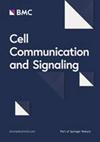脂肪细胞衍生的外泌体促进细胞侵袭并挑战紫杉醇在卵巢癌中的疗效
IF 8.2
2区 生物学
Q1 CELL BIOLOGY
引用次数: 0
摘要
上皮性卵巢癌(EOC)是最致命的妇科癌症,由于对化疗普遍产生抗药性,因此死亡率很高。EOC 常常侵犯网膜,网膜是腹膜中脂肪细胞丰富的器官,网膜脂肪细胞与促进疾病进展、转移和化疗耐药性有关。EOC网膜趋向性的信号机制尚待阐明。我们使用三维共培养模型来探索脂肪细胞-EOC之间的相互作用。评估了脂肪细胞对 EOC 增殖、治疗反应和侵袭能力的影响。从卵巢恶性肿瘤和良性卵巢肿瘤患者身上分离出原发性脂肪细胞和网膜组织。从网膜组织条件培养基中分离出外泌体,并评估网膜衍生外泌体对 EOC 的影响。利用外泌体微RNA(miRNA)测序技术鉴定了网膜外泌体中丰富的miRNA,并用高含量的miRNA miR-21、let-7b、miR-16和miR-92a转染了EOC细胞。我们证明了脂肪细胞有能力通过驱动上皮细胞向间质转化(EMT)来诱导 EOC 群体的侵袭表型。卵巢癌患者以及无恶性肿瘤患者的网膜组织分泌的外泌体诱导了EOC细胞系和HGSOC患者样本的增殖,上调了EMT标记物,并降低了对紫杉醇疗法的反应。对癌症患者网膜衍生的外泌体进行分析后,发现了高度丰富的miRNA,包括miR-21、let-7b、miR-16和miR-92a,它们转染卵巢癌细胞后可促进癌细胞增殖并保护细胞免受化疗的影响。这些观察结果突显了网膜脂肪细胞在卵巢癌和其他与脂肪相关的恶性肿瘤中产生促肿瘤生成和化学保护微环境的能力。本文章由计算机程序翻译,如有差异,请以英文原文为准。
Adipocyte derived exosomes promote cell invasion and challenge paclitaxel efficacy in ovarian cancer
Epithelial ovarian cancer (EOC) is the deadliest gynaecological cancer with high mortality rates driven by the common development of resistance to chemotherapy. EOC frequently invades the omentum, an adipocyte-rich organ of the peritoneum and omental adipocytes have been implicated in promoting disease progression, metastasis and chemoresistance. The signalling mechanisms underpinning EOC omentum tropism have yet to be elucidated. Three-dimensional co-culture models were used to explore adipocyte-EOC interactions. The impact of adipocytes on EOC proliferation, response to therapy and invasive capacity was assessed. Primary adipocytes and omental tissue were isolated from patients with ovarian malignancies and benign ovarian neoplasms. Exosomes were isolated from omentum tissue conditioned media and the effect of omentum-derived exosomes on EOC evaluated. Exosomal microRNA (miRNA) sequencing was used to identify miRNAs abundant in omental exosomes and EOC cells were transfected with highly abundant miRNAs miR-21, let-7b, miR-16 and miR-92a. We demonstrate the capacity of adipocytes to induce an invasive phenotype in EOC populations through driving epithelial-to-mesenchymal transition (EMT). Exosomes secreted by omental tissue of ovarian cancer patients, as well as patients without malignancies, induced proliferation, upregulated EMT markers and reduced response to paclitaxel therapy in EOC cell lines and HGSOC patient samples. Analysis of the omentum-derived exosomes from cancer patients revealed highly abundant miRNAs that included miR-21, let-7b, miR-16 and miR-92a that promoted cancer cell proliferation and protection from chemotherapy when transfected in ovarian cancer cells. These observations highlight the capacity of omental adipocytes to generate a pro-tumorigenic and chemoprotective microenvironment in ovarian cancer and other adipose-related malignancies.
求助全文
通过发布文献求助,成功后即可免费获取论文全文。
去求助
来源期刊

Cell Communication and Signaling
CELL BIOLOGY-
CiteScore
11.00
自引率
0.00%
发文量
180
期刊介绍:
Cell Communication and Signaling (CCS) is a peer-reviewed, open-access scientific journal that focuses on cellular signaling pathways in both normal and pathological conditions. It publishes original research, reviews, and commentaries, welcoming studies that utilize molecular, morphological, biochemical, structural, and cell biology approaches. CCS also encourages interdisciplinary work and innovative models, including in silico, in vitro, and in vivo approaches, to facilitate investigations of cell signaling pathways, networks, and behavior.
Starting from January 2019, CCS is proud to announce its affiliation with the International Cell Death Society. The journal now encourages submissions covering all aspects of cell death, including apoptotic and non-apoptotic mechanisms, cell death in model systems, autophagy, clearance of dying cells, and the immunological and pathological consequences of dying cells in the tissue microenvironment.
 求助内容:
求助内容: 应助结果提醒方式:
应助结果提醒方式:


